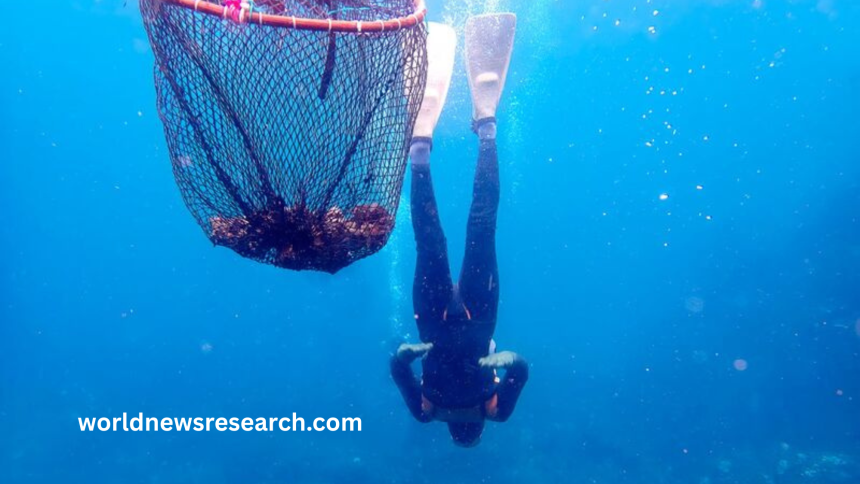Beneath the shimmering surface of the ocean lies a world few truly understand—one inhabited by remarkable individuals often referred to as “real-life mermaids.” These divers, renowned for their extraordinary underwater abilities, combine a fascinating mix of genetics, training, and cultural heritage to achieve feats that most people could only dream of. From holding their breath for astonishing lengths of time to diving to incredible depths without any breathing apparatus, their capabilities challenge our understanding of human limits and biology.
The Origins of Real-Life Mermaid Divers
The phenomenon of “real-life mermaid divers” is deeply rooted in ancient traditions and coastal cultures worldwide. Communities living by the sea, particularly in East Asia, the Mediterranean, and parts of the Pacific, have for centuries relied on freediving as a means of livelihood—harvesting seafood, collecting pearls, or gathering underwater resources. Over generations, these communities developed unique techniques and lifestyles that allowed them to thrive beneath the waves.
One of the most famous groups associated with these incredible underwater skills is the Ama divers of Japan. Known as “sea women,” the Ama have been diving for shellfish, seaweed, and pearls for thousands of years. Their ability to dive repeatedly without modern equipment is legendary. Similar groups exist in Korea, Indonesia, and the Philippines, each with their own distinct traditions but sharing the common thread of exceptional freediving.
Remarkable Underwater Abilities
At the heart of these divers’ skills is their ability to hold their breath for remarkably long periods and to dive to extreme depths. Some experienced freedivers can stay underwater for several minutes on a single breath, while others descend tens of meters below the surface with nothing but their own lungs and training.
This ability, known as apnea, is both a physical and mental challenge. It requires not only efficient oxygen use but also a calm, focused mind to manage the natural urge to breathe. Many of these divers use techniques such as slow, deep breathing and meditation to prepare their bodies before dives.
Moreover, their bodies exhibit physiological adaptations that enhance their underwater performance. These include an increased lung capacity, a slower heart rate during dives (known as the mammalian dive reflex), and a greater tolerance for high levels of carbon dioxide. These adaptations help conserve oxygen and allow for longer and deeper dives.
Genetics Behind the Dive
Recent scientific studies have begun to explore the genetics behind these extraordinary underwater abilities. Research on populations like the Bajau people of Southeast Asia, often called “sea nomads,” has revealed fascinating genetic traits linked to freediving.
The Bajau, who have lived at sea for centuries, display larger spleens compared to neighboring groups. The spleen plays a crucial role in oxygen management by releasing extra red blood cells during extended dives, effectively acting as a natural oxygen reservoir. This adaptation allows the Bajau to hold their breath longer and dive deeper without experiencing oxygen deprivation.
Genetic analysis indicates that this trait has evolved over generations of living in a marine environment. It’s a compelling example of how human populations can adapt to extreme environmental demands through natural selection, enhancing their survival and way of life.
Training and Mental Discipline
While genetics provide a foundation, much of the freediving ability is honed through rigorous training and mental discipline. The real-life mermaid divers practice breath-holding exercises, physical conditioning, and meditation techniques designed to calm the nervous system and improve oxygen efficiency.
Mental resilience is a key factor in successful freediving. Divers learn to manage the discomfort and natural anxiety associated with breath-holding and pressure changes at depth. This psychological training allows them to remain calm and focused, preventing panic and conserving precious oxygen.
Many divers also develop a strong connection to the ocean, cultivating an intuitive understanding of tides, currents, and marine life behavior. This knowledge further enhances their safety and effectiveness underwater.
Cultural Significance and Modern-Day Freediving
For many communities, freediving is not just a survival skill but a cultural heritage passed down through generations. The rituals, stories, and traditions surrounding diving connect divers to their ancestors and the sea itself.
In recent decades, freediving has gained popularity worldwide as a sport and recreational activity. Modern freedivers push the limits of human performance, competing in depth, duration, and dynamic apnea disciplines. However, the traditional real-life mermaid divers remain a living link to a more ancient way of interacting with the ocean.
Some divers have also become environmental advocates, raising awareness about ocean conservation. Their intimate relationship with the sea fosters a deep respect for marine ecosystems, inspiring efforts to protect underwater habitats from pollution, overfishing, and climate change.
The Science of Breath-Holding
Understanding the science behind breath-holding helps explain the remarkable capabilities of these divers. When a person holds their breath, the body initiates the mammalian dive reflex, a set of physiological responses designed to conserve oxygen. These responses include slowing the heart rate, constricting blood vessels in non-essential areas, and redirecting blood flow to vital organs like the brain and heart.
The mammalian dive reflex is stronger in some individuals and can be trained to become more effective. The real-life mermaid divers optimize this reflex through practice, allowing their bodies to function efficiently under low oxygen conditions.
Challenges and Risks
Despite their skills, freediving remains a risky activity. The dangers include shallow water blackout, hypoxia (oxygen deprivation), and barotrauma (injury caused by pressure changes). Many traditional divers learn to mitigate these risks through experience, buddy systems, and conservative diving practices.
The physical demands and risks mean that not everyone can safely perform at these levels, emphasizing the importance of training, respect for the ocean, and awareness of one’s limits.
Frequently Asked Questions
What is a real-life mermaid diver?
A real-life mermaid diver is someone with the ability to dive deep underwater without the aid of scuba gear or breathing equipment. These divers are often part of traditional coastal communities and have developed exceptional breath-holding and swimming abilities through a combination of genetics, training, and experience.
Which cultures are known for real-life mermaid diving?
Several cultures around the world are known for their freediving traditions. Notable among them are the Ama of Japan, the Haenyeo of Korea, and the Bajau of Southeast Asia. These groups have practiced breath-hold diving for centuries, often for harvesting seafood or collecting underwater resources.
Are their diving abilities purely genetic?
Not entirely. While some genetic adaptations, such as larger spleens or efficient oxygen use, have been identified in groups like the Bajau, much of their ability comes from rigorous training, experience, and a deep understanding of the ocean environment.
What kind of training do these divers undergo?
Training typically includes breath-holding exercises, controlled exposure to depth, physical fitness routines, and mental conditioning. Many divers also practice meditation or breathing techniques to calm their nervous system and increase oxygen efficiency.
What is the mammalian dive reflex?
The mammalian dive reflex is a natural physiological response triggered when the face is submerged in water. It slows the heart rate, redirects blood to vital organs, and helps conserve oxygen—enhancing a person’s ability to stay underwater longer.
Is freediving dangerous?
Freediving does carry risks, including shallow water blackout, hypoxia, and pressure-related injuries. However, experienced divers manage these risks with proper training, safety practices, and respect for their limits.
Can anyone become a freediver like these mermaid divers?
Most healthy individuals can learn basic freediving techniques with proper instruction and practice. However, reaching the level of traditional mermaid divers often requires years of experience, dedication, and sometimes inherited traits that support advanced underwater performance.
Conclusion
The story of real-life mermaid divers is a remarkable intersection of human biology, culture, and the enduring bond between people and the ocean. These individuals, whether rooted in ancient tradition or modern sport, challenge our understanding of what the human body and mind are capable of beneath the waves.



